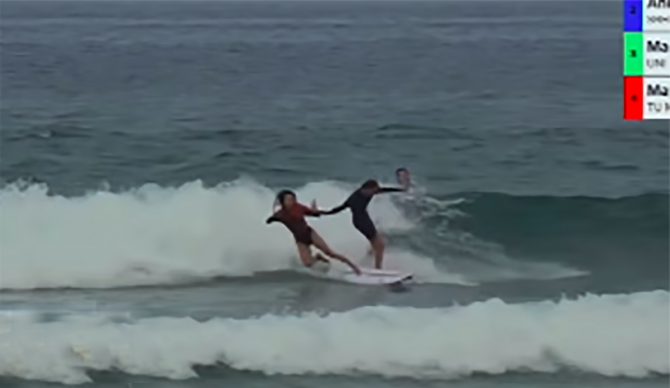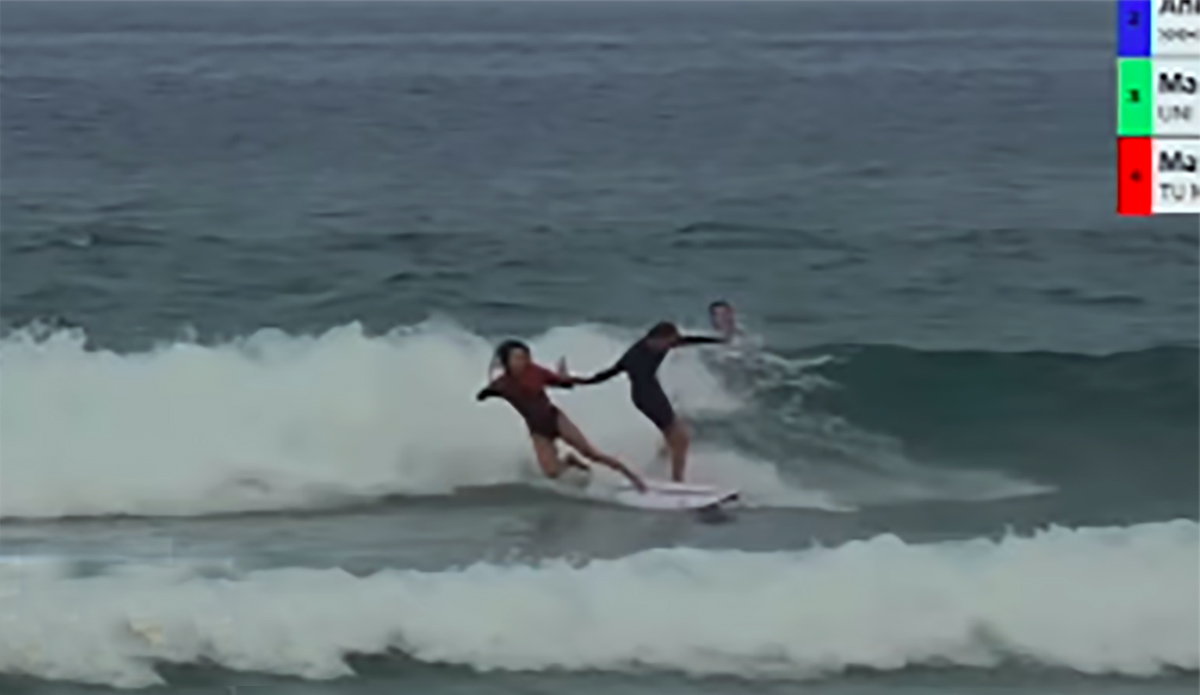
Local surfers gave competitors at the German contest a taste of localism. Photo: Screenshot
![]()
A video of a French freesurfer entering the site of a German university competition and pushing a competitor off her board has been viewed more than three-million times (the Instagram video has since been deleted). At first glance, it might seem like an isolated act of a disgruntled surfer. But beneath the surface lies a deeper tension simmering along France’s southwest coast. The influx of foreign surf camps and competitions has left many French surfers and surf instructors feeling disenfranchised at their home beaches.
We spoke with seven local surfers about the June 2025 push and underlying friction. While all agreed that a rift is forming, they don’t necessarily agree on why. (All individuals quoted requested anonymity, and their names have been changed so they could speak openly about the issue.)
“Most locals are not a fan of this (German) contest,” said Antoine, a surfer from the Seignosse area. “Same with all the other German and Dutch surf camps around Moliets. There are hundreds or thousands (of surfers), not always with the best surf etiquette. They have their businesses and instructors, so locals don’t get many benefits, just the sand banks filled with tourists coming in big groups.”
Antoine says that, to be fair, in his experience running local French contests, he has also encountered issues with freesurfer interference. Still, he is unequivocal in his disapproval of the viral push.
“It can be very frustrating to see so many people taking the best bank, but you can’t act like that,” he added.
Hugo, a Hossegor-based surfer with strong ties to the local surf industry, echoes Antoine that the freesurfer’s actions were a “pathetic” way to act, especially toward a woman. However, he knows surfers in the community who applaud the push. He admits that the seasonal surge of surfers, largely from landlocked European countries, has created widespread frustration among locals.
“There is tension in Hossegor and Seignosse at the moment,” Hugo explained. “The surf is packed beyond belief anytime it’s two feet and not completely blown out.”
“There were plenty of places to go where you could surf with fewer crowds,” Hugo added about the German contest. “It’s harder (to get there), yes. But in reality, anyone who went (to the contest beach) was looking for a confrontation, a way to vent their anger.”
According to Hugo, blaming the German surfers is misplaced – “shooting the messenger.” The real problem, he says, is the municipalities that sanction too many events and the campsites that book out to the foreign surf camps.
Mateo, a French surfer with media experience, agreed that too many events are being sanctioned to the detriment of local surfers. He anecdotally pointed out that the Landes department applied for a permit to run their state championships at Moliets, but the German contest had already reserved the dates. Mateo noted that the right to run events solely lies with each municipality, except in cases where the prize purse is more than €3,000, which requires approval from the French Surfing Federation.
Even more than a month after the viral push, confusion persists among the local community as far as what exactly occurred. Another local surfer, Lucas, pointed to a longer version of the viral video, which shows the pushed surfer dropping in on the freesurfer – a moment omitted from the viral clip. You can see the full chaos in the video below. He says local surfers were frustrated because they felt the contest had expanded its footprint to a different peak that had not previously been included in the contest zone, and that’s why the surfer dropped in.
When we spoke with two German officials involved in the event, they insisted that they had the proper permits to run on the sand bank where the drop-in occurred. While they were unable to furnish the document that granted such rights due to “data protection regulations,” they stressed that they have annually run the event in Seignosse since 2004 and have never had such an issue.
The Germans suggest the confusion might stem from previous days of the event, where the contest director found ways to accommodate freesurfers and share the sand banks. In the viral clip, you can see at least 10 freesurfers mixed in with the contest. But that particular day, the conditions called for the utilization of the entire sand bank. This information, they say, was communicated to freesurfers by the local lifeguards, and they are already in talks with the Seignosse municipality to prevent such incidents in the future.
Lucas agrees with Antoine that the foreign contests are not the source of discontent. He says that Czech, Belgian, and German contests, among others, have been going on for years without issue. He laments the size of the camp tied to the university contest in Moliets, which he estimates drew around 600 surfers the first week and 1,000 the second. However, in his eyes, the root of the issue is unfair competition between French and foreign surf instructors.
“Foreign contests are just one percent of the traffic; it’s not even an issue,” argued Lucas. “When you go to Australia or California, you have surf clubs or schools, but not to the extent we have here – it’s a big business in France.”
French surf instructors are required by law to obtain the French certification, which is more demanding and costly than parallel international certifications, such as those from the International Surfing Association (ISA). Obtaining the French certificate is a process that Mateo says can take years and ranges in cost from €2,800 to €6,000, depending on the training center and type of program. In contrast, he says the ISA base certification, when accompanied by first aid training, can be obtained for €900 in 80 hours.
“You can understand why many French instructors are pretty pissed off at foreign instructors who come to work with just a level 1 ISA certification,” said Mateo.
A petition circulated in 2022 to stop foreign surf camps from overcrowding the beach in Moliets. Among its long list of grievances was the fact that the foreign instructors were unfairly allowed to operate without the more rigorous French certificate.
French law requires that surf schools operate with a maximum of eight students per instructor. However, locals claim that foreign camps haven’t been following this law as closely as French schools. An article published in Surf Session in 2021 reported the Landes department inspected 10 of the 46 registered foreign surf camps and 35 of the 112 French surf schools, finding that “the rate of non-compliance was slightly higher in foreign surf camps.”
Maxime, who has deep knowledge of the French certification process, questions the legitimacy of many of the foreign surf camps. He pointed to an Instagram post criticizing a potentially uncertified foreign instructor for advertising surf classes.
“Most of the time (the foreign camps use) an internal system as far as accommodation, food, drink, activities, and board repairs, all at discounted prices,” said Maxime. “How do those surf camps manage to undercut the costs of surf lessons? Are these surf camps declared? Are the instructors qualified and experienced? Where do they pay their taxes? Taxes in France are very heavy for entrepreneurs and businesses. For many, it looks like unfair competition.”
“I have seen groups of about 30 students with three instructors in lycras and a whistle (standing on the sand),” Maxime added. “‘Pirate’ surf camps and schools often do not have the permission to teach in monitored areas. They clearly lack safety training, which increases risks.”
Maxime thinks that foreign camps and competitions should introduce themselves to the local French surf clubs to create an open line of communication. He proposes that they use a certain percentage of French employees for their camps and contests, taking a more collective approach to regulating the flow of surfers in the region.
None of the surfers we spoke to made excuses for the freesurfer’s aggressive actions during the German competition. But all agree that the protest and discontent behind the push are based on various, real grievances shared by many. As surfing continues to grow in popularity among European landlocked nations – particularly as wave pools proliferate – the summertime pressure on France’s crowded southwest coast shows no signs of easing.
